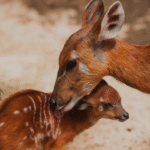
THE DESERT’S VIGILANT GUARDIANS: THE MEERKAT
Meerkats (Suricata suricatta) are small, diurnal members of the mongoose family, weighing between 600 and 1,000 grams and measuring 25–35 cm in length. Their well-loved social nature and characteristic upright posture have made them popular emissaries for African wildlife.
These animals exhibit some of the most complex social behavior in the animal kingdom, living in close family units known as mobs or clans. Members of a mob exhibit a sophisticated collective culture that includes cooperative foraging, pup “babysitting,” and sentinel duties, showcasing remarkable collaboration.
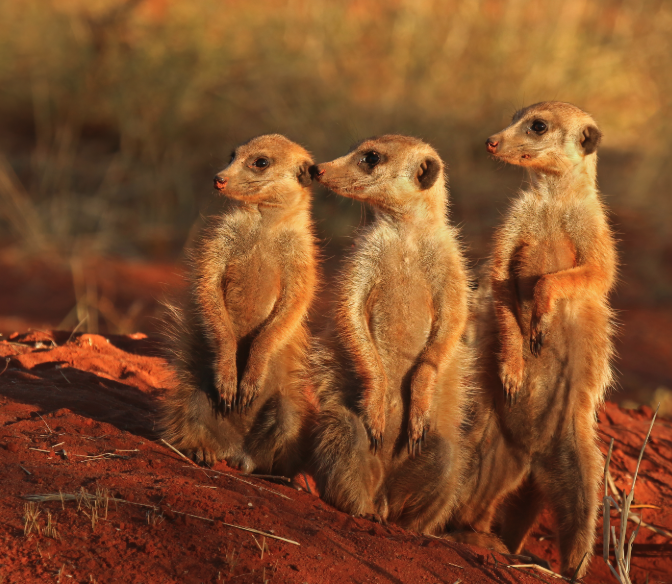
Their distribution across southern Africa has led to the development of numerous survival adaptations. Their light brown or grizzled grey fur protects them from the harsh African sun, while dark eye patches reduce glare and enhance their ability to spot aerial predators.
What truly differentiates meerkats, beyond their social structure, is their sophisticated communication system. They possess over 30 distinct vocalizations to indicate various types of threats, a characteristic that is unique in its complexity.
Body Structure
The meerkat’s body is a finely tuned product of evolution, perfectly adapted to the challenges of life in the arid and semi-arid regions of southern Africa. Its small, slender frame—measuring about 25–35 cm in body length with an additional 17–25 cm tail makes it agile and able to maneuver quickly through burrows and dense scrub. The tail is long and thin with a darker tip, acting as a counterbalance when the animal stands upright and serving as a visible signal for group members to follow during movement across open terrain.
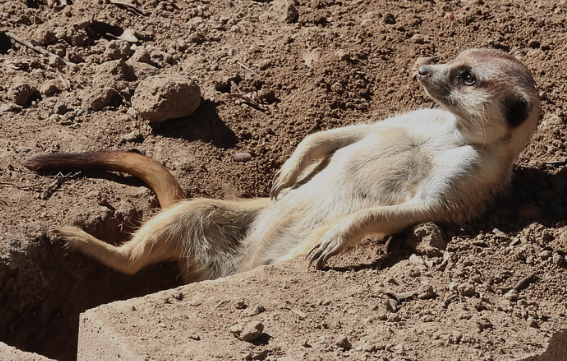
One of its most distinctive features is its head, which has a pointed snout and a long, narrow muzzle that enables it to probe into crevices and loose soil in search of prey. The nose is equipped with a tough, leathery pad to withstand digging, and the ears are small and crescent-shaped, capable of closing tightly to keep out sand while burrowing. The eyes are large and dark, surrounded by dark patches of fur that act like built-in “sunglasses” to reduce glare from the intense desert sun and enhance focus on distant predators. This is complemented by exceptional vision, which allows meerkats to detect aerial and ground threats from far away.
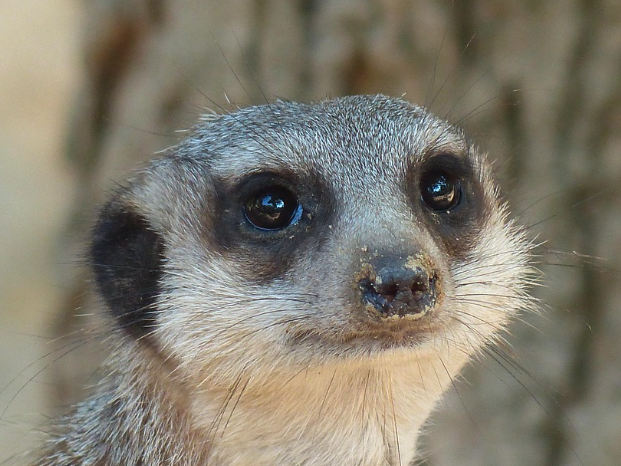
The forelimbs are another critical adaptation, featuring long, curved, non-retractable claws up to 2 cm in length. These claws are powerful digging tools, enabling meerkats to excavate complex burrow systems and rapidly unearth insects, lizards, or roots from compacted soil. The hind limbs are strong and slightly elongated, supporting their habit of standing upright for extended periods during sentry duty.

Their coat is short, coarse, and generally light brown to sandy in color, patterned with faint stripes along the back. This coloration provides effective camouflage against the desert backdrop, helping them avoid detection by predators. The fur also plays a role in thermoregulation: it is light enough to reflect some of the sun’s heat yet dense enough to offer insulation during cold desert nights. Beneath the fur, a thin layer of fat helps them cope with temperature fluctuations without adding bulk that would hinder agility.
Finally, the meerkat’s overall physiology is adapted for survival with minimal water. They obtain most of their moisture from food, particularly insects and succulent plants, reducing their dependence on standing water, which is often scarce in their environment.
Natural Habitat and Geographical Distribution
The distribution of meerkats is limited to southern Africa, with the Kalahari Desert as their core area of occupation.
The meerkat’s range in the Kalahari Desert encompasses parts of Botswana, Namibia, and South Africa. This environment, characterized by sparse vegetation and sandy soil, perfectly suits their adaptations. Their habitat also extends into the southern part of Namibia.

Populations can also be found in the semi-arid scrublands of Zimbabwe, Angola, and Mozambique, though they are scarce due to water shortages. The ecosystems in these regions, featuring limited low vegetation, compacted sandy soil, and sparse rainfall, are also well-suited to the meerkat’s adaptations.
Meerkats face the challenge of thermoregulation against harsh desert heat, a problem they minimize by burrowing into the sand. As obligate burrowers, they depend on elaborate systems of tunnels, which provide a stable internal temperature ranging from 25 to 30°C. This stable environment allows them to escape the desert’s extreme temperature fluctuations. The burrows enable meerkats to thermoregulate effectively; for instance, when the temperature drops to a comfortable 25°C, they can sleep with ease.

In addition to temperature control, the burrows act as protective shields from predators such as snakes, jackals, and raptors. The multiple entrances and escape routes provide crucial cover and avenues for evasion. Furthermore, the burrows provide a haven for meerkats to raise their pups, sheltered from the desert’s harsh conditions.

A meerkat burrow is architecturally remarkable. The underground passages can reach depths of 2 meters and extend 5 to 30 meters in length. A single burrow system can have between 5 and 15 exits, often cleverly hidden under bushes for enhanced protection. Interestingly, meerkats are not solitary underground dwellers. They often share these extensive burrows with yellow mongooses (Cynictis penicillata), ground squirrels (Xerus inauris), and even some non-predatory snakes, demonstrating remarkable interspecies cohabitation in the harsh African landscape.
Subspecies and Genetic Variations
Meerkats are classified into three subspecies based on geographical distribution, size, and fur coloration. Suricata suricatta suricatta, the largest subspecies identified by its darker fur, is found in South Africa and Botswana. Another subspecies, S. s. majoriae, is found in central Namibia and has lighter fur. The smallest and rarest subspecies is found in southwestern Angola. Its limited geographic range and small population size make it the least researched.
The evolutionary history of meerkats dates back to the Miocene epoch, around ten to fifteen million years ago, when they diverged from other mongooses. The need to survive in predator-rich environments shaped the highly social and cooperative behavioral traits that define the species today.
Feeding Ecology and Hunting Strategies
Diet Composition
Meerkats are insectivorous generalists. Insects such as beetles, termites, and grasshoppers form the bulk of their diet (approximately 82%). Scorpions and spiders make up about 7%, and small vertebrates like lizards, snakes, rodents, and birds constitute another 5%. The remaining 2% consists of plant matter, primarily roots, tubers, and moisture-rich tsama melons, which are crucial during dry seasons.
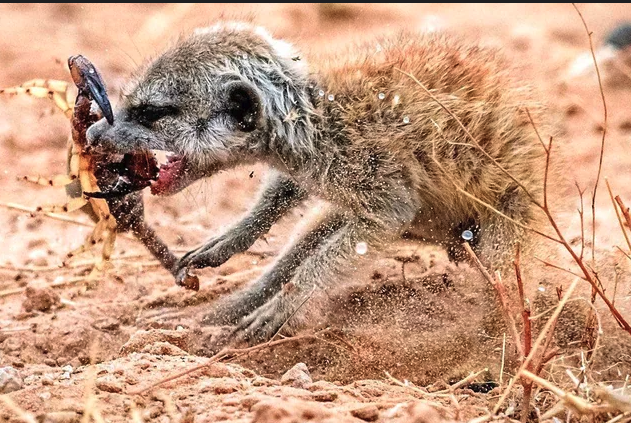
Hunting Techniques
During cooperative foraging, individuals spread out to search for food while a designated sentry watches for predators. Meerkats are well-adapted for digging, using their long, curved claws to uncover prey. They also possess a remarkable resistance to venom, which allows them to safely eat scorpions. A notable aspect of their behavior is “pup tutoring,” where skilled adults teach younger members how to disable a scorpion’s stinger before consuming it, a rare example of active teaching in the animal kingdom.
Reproductive Biology and Social Structure
Meerkat societies are organized into tightly knit groups, or “mobs,” governed by a strict matriarchal hierarchy. The alpha female, who is the sole breeding female in roughly 80% of cases, is paired with an alpha male, her primary mate, who helps defend the territory. The remaining members are subordinates, often close relatives, who rarely reproduce but contribute significantly to pup rearing, foraging, and vigilance.
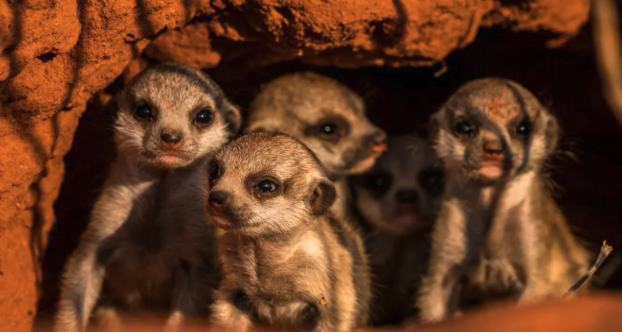
Breeding is highly coordinated, with a gestation period of 70–77 days resulting in litters of two to seven pups (averaging around four). Pups are weaned between seven and nine weeks of age and achieve independence by three to four months. Reproductive competition can be intense; dominant females sometimes commit infanticide by killing the offspring of subordinates to maintain reproductive control. In turn, some subordinates attempt “sneak matings” to bypass this suppression, adding an undercurrent of conflict to the group’s otherwise cooperative nature.

Conservation Status and Threats
The meerkat (Suricata suricatta) is currently classified by the International Union for Conservation of Nature (IUCN) as a species of Least Concern, with stable population estimates of approximately 500,000 individuals across southern Africa. Their resilience is attributed to their adaptability to harsh environments, complex social structure, and their presence within several protected areas.
Despite this stable status, localized declines occur due to human activity. Habitat loss from agricultural expansion, overgrazing, and development is a moderate concern, though protected zones like the Kgalagadi Transfrontier Park safeguard significant portions of their habitat. Climate change poses a growing threat, as shifting rainfall patterns and prolonged droughts alter food availability and burrow stability. Predation by eagles, jackals, and snakes remains a constant high-level threat, which their sophisticated sentinel system helps to mitigate. These factors highlight the delicate balance between the meerkat’s adaptability and ongoing environmental challenges.
Unique Adaptations and Behaviors
Meerkats have evolved sophisticated anti-predator strategies that rely on group coordination and communication. The sentinel system is central to their defense: individuals take turns acting as lookouts while the group forages. Sentinels use distinct alarm calls to specify the type of threat; an “aerial predator” call prompts the group to dive for cover, while a “ground predator” alert may trigger a mobbing response to intimidate the intruder. Social positioning also enhances safety, with younger or more vulnerable individuals often kept toward the center of the group—a behavior known as the “selfish herd” effect that reduces their individual risk.
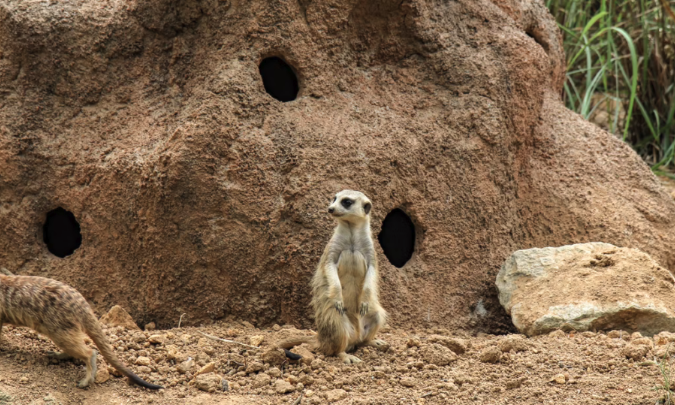
Beyond their own species, meerkats engage in mutualistic relationships that enhance survival. They forage alongside hornbills, which act as an additional early warning system for predators. They also share burrow systems with ground squirrels in a commensal relationship; this arrangement provides both species access to secure shelter without direct competition for food, underscoring the meerkat’s adaptability within the desert ecosystem.
Conclusion
Meerkats play a critical role as ecosystem engineers: they control insect populations, aerate soil through digging, and serve as prey for larger carnivores. Their complex social systems offer valuable insights into the evolution of cooperation. Future conservation efforts must focus on habitat preservation and promoting climate resilience to ensure their long-term survival.
For wildlife enthusiasts, observing a meerkat mob—vigilant, cooperative, and endlessly resourceful—is a testament to nature’s ingenuity.



